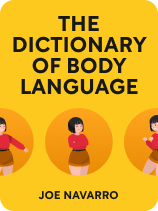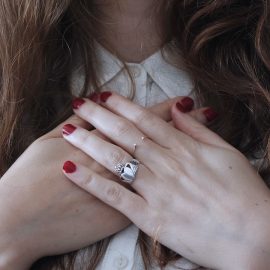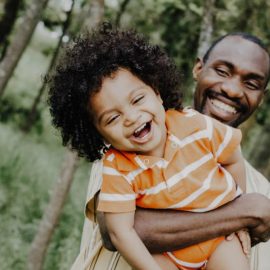

This article is an excerpt from the Shortform book guide to "The Dictionary of Body Language" by Joe Navarro. Shortform has the world's best summaries and analyses of books you should be reading.
Like this article? Sign up for a free trial here.
What does it mean when someone purses their lips? Why do people turn their feet away from others? Can you tell what someone’s feeling, despite what they’re saying?
Joe Navarro, a retired FBI Special Agent, knows how to read people. In The Dictionary of Body Language, he examines some of the body language cues that indicate emotions, such as repetitive actions that suggest anxiousness and tense postures that indicate anger.
Keep reading to learn how to read emotions through body language.
How to Read Emotions
We’ll touch on many of the specific body language cues Navarro describes in his tips on how to read emotions. We’ve grouped these cues based on the common emotions they indicate: stress and anxiety, boredom and impatience, disagreement and doubt, anger and irritation, discomfort and aversion, comfort and confidence, and excitement.
Stress and Anxiety: Repeated Actions
According to Navarro, many body language cues that signal stress and anxiety involve repeated actions. Repetition has a calming, settling effect on the nervous system. Therefore, if someone repeats the same behavior over and over in a short period of time, they’re likely attempting to soothe themselves.
Navarro names the following as common body language cues that involve calming, repeated actions:
Action #1: Massaging the Chest From the Shoulder and Across the Collarbone
Navarro describes how, when engaging in this calming, tactile action, people place a hand on the shoulder opposite (right hand to left shoulder or left hand to right shoulder). They then move their hand along the collarbone from their shoulder to their chest.
Action #2: Swaying the Torso Forward and Backward Starting at the Hips
Repeatedly swaying the upper body forward and backward while sitting down is frequently an indicator of intense psychological distress. Navarro asserts that you might observe this action in people attempting to calm themselves while experiencing a traumatic event.
However, he states that this is also a common action undertaken by neurodivergent people (who aren’t necessarily in distress), such as people on the autism spectrum. So, context is important when assessing this cue.
Stress and Anxiety: Cooling Actions
Navarro argues that many cues that indicate anxiousness and stress (and our desire to soothe these feelings) have a cooling effect. When we’re feeling stressed, our bodies get uncomfortably warm. Therefore, we seek to return our bodies to a cooler, more comfortable temperature.
Before assessing the driving factor behind these behaviors, however, Navarro suggests considering the context of the situation. Specifically, he notes that a high ambient temperature may prompt these behaviors by making people feel warm. In this case, internal stress may or may not be involved, so use other cues to judge the person’s emotions.
The following body language cues calm by cooling, suggesting that the person displaying them may be overheated because of anxiety or stress.
Action #1: Increasing Airflow to the Body
According to Navarro, people will commonly try to cool their bodies when stressed by increasing airflow to their skin. For example, you might see a stressed, overheated person adjusting their hair to increase airflow to the head and neck: Men usually cool the top of their heads by threading their fingers through their hair, while women typically hold up their hair from the back of their neck.
Action #2: Sweating Profusely
Navarro states that you may observe people sweating profusely when they’re stressed. He notes that this is especially common when someone’s nervous or trying to deceive you. Sweating is their body’s way of cooling them down—the added moisture creates a cooling effect as it evaporates from the skin.
Boredom and Impatience
Boredom is another emotion you can often read through body language. Navarro names the following cues as typical indicators that someone’s bored or feeling impatient:
Action #1: Resting the Chin on the Hands, With Slack Features
According to the author, people who are bored often rest their chin on their hands (palms up) while wearing a slack expression.
Action #2: Tapping the Fingers in a Cascading Pattern
Navarro argues that when people tap their fingers on a surface, starting with one finger and then following with the others in a quick, cascading pattern, it usually indicates that they’re impatiently waiting for someone or something to finish. For example, you might see students doing this as they’re waiting for class to end.
Disagreement and Doubt
If you see someone displaying the following body language cues, Navarro states that they likely disagree with or doubt something that’s been said:
Action #1: Pursing the Lips
When someone’s mouth pulls tightly in at the sides and pushes forward to form a rounded shape, it’s typically a signal of disagreement or disapproval. According to the author, the prominence of the forward lip-pushing typically correlates with the level of their disapproval—the more forward the mouth pushes, the more intense the emotion is.
(Shortform note: Pursing your lips may have the negative effect of offending others by signaling disapproval, but it’s also good for modulating breathing. Inhaling and exhaling with pursed lips slows the pace of your breathing, improves shortness of breath, and increases the oxygen flow to your lungs. It can be especially helpful for people with lung diseases such as asthma and chronic obstructive pulmonary disease (COPD).)
Action #2: Raising One Eyebrow
According to the author, people sometimes raise one eyebrow and keep the other in a normal or lowered position to communicate doubt about something that’s been said. It’s a nonverbal form of questioning.
(Shortform note: This nonverbal cue isn’t something that everyone can use—only about 30% to 40% of people are able to raise one eyebrow at a time. Some experts attribute this ability to greater dexterity of the muscles on one side of the face, and others believe that we have a dominant eyebrow like we have a dominant hand. Still others think the ability may be passed down genetically.)
Anger and Irritation
Signs of anger and irritation in body language often involve muscles tensing and constricting. Navarro gives the following examples of anger-related cues:
Action #1: Narrowing the Eyes
Some people who are angry will narrow their eyes slightly, so the part of their eyes that you can see becomes smaller. Navarro advises paying attention to the other body language cues that accompany this, as narrowed eyes can have multiple meanings—if someone’s truly angry, you’ll likely see tension in other parts of the face and the body, such as the jaw.
Action #2: Tightening the Jaw
According to the author, anger also often manifests itself in the jaw. You might see angry people with tight, tense jaw muscles.
Discomfort and Aversion
Navarro notes that body language that displays discomfort or aversion is typically closed and defensive, indicating that someone feels the need to protect themselves or step away from the situation.
Navarro offers the following cues for identifying discomfort in somebody’s body language:
Action #1: Folding the Arms Across the Torso
According to the author, people often fold their arms together and hold them against their torso as if they’re giving themselves a hug—this can be a way to soothe mild discomfort, and it may not indicate distress.
However, this posture can also suggest that someone’s trying to protect themselves because they feel unsure or unsafe. Folded arms cover the soft front torso, which contains many of the most important and vulnerable internal organs. Therefore, when we feel unsafe, we instinctively seek to protect this area.
Action #2: Positioning a Fist in Front of the Throat
According to Navarro, when people make a fist and put it in front of their throat, they’re demonstrating fear and discomfort. The gesture is defensive, protecting the soft, vulnerable part of the throat from perceived danger.
Action #3: Angling the Feet Away From Someone
Navarro states that people often angle their feet away from someone they don’t like. In social situations, this is a reliable indicator of people’s true feelings, even if they’re smiling and being polite.
Comfort and Confidence
In contrast to the tense, protective postures of people who are uncomfortable, angry, or afraid, people who feel comfortable and confident usually display body language that’s open and relaxed.
Navarro suggests that the following actions indicate comfort and confidence:
Action #1: Relaxation of the Eye Muscles
Navarro states that comfortable people have relaxed muscles all around the face, especially near the eyes. In contrast, uncomfortable people show tension in these muscles, which may appear as squinting or scrunching of the skin. The muscles surrounding the eyes tend to show tension before other parts of the face, so this is a good spot to observe real-time changes in someone’s mood.
Action #2: Opening of the Shoulders
According to Navarro, a strong signal of confidence is extending the shoulders to be wide and open. You might observe this in people with authority and power, such as business executives. This pose contrasts with the looser, more inward posture of someone who’s less confident.
Excitement
Finally, Navarro describes several cues that indicate excitement. These often involve springy, energetic, upward movements.
The following are two examples of excited behaviors:
Action #1: Rapidly Raising and Lowering the Eyebrows
Navarro notes that when greeting friends and family, people often quickly raise and lower their eyebrows in a single movement. The movement happens in less than a second. This signifies that someone’s happy and excited to see the person they’re greeting.
Action #2: Being Springy on the Feet
Sometimes, when someone’s excited, they’ll spring up and down on their feet. According to Navarro, you’ll most often observe this behavior in children, but adults also do it occasionally.

———End of Preview———
Like what you just read? Read the rest of the world's best book summary and analysis of Joe Navarro's "The Dictionary of Body Language" at Shortform.
Here's what you'll find in our full The Dictionary of Body Language summary:
- A former FBI Special Agent's guide to body language
- Why you should assess body language cues collectively, not individually
- The body language cues that indicate stress, boredom, anger, doubt, and more






